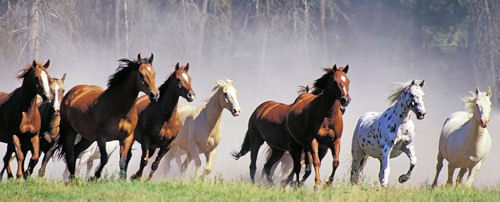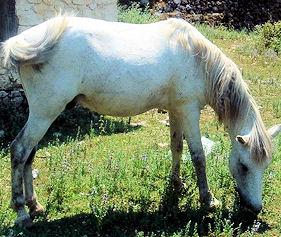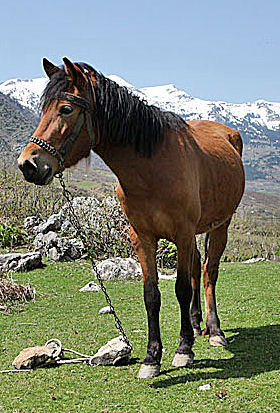The Albanian Horse is a small horse which belongs to the Balkan group. It is hardy and very efficient. The Myzeqea type is larger and can grow up to 13.2 hands high, while the mountain type ranges from 12.2hh to 13.2hh. Albanian horses are used as carriage horses and for riding and light draft work.
The Albanian breed is part of the larger Balkan breed. As such, its physical characteristics are very similar to horses in the Balkan region. Specifically, their look and form is similar to those of the horses found in the mountains of Bosnia Herzegovina and the Rodope Mountain Range.
Albania, due to years under a very isolating and repressive government, is one of the least developed European countries. There are wild forests and mountains, and there is still a heavy reliance on horses for agricultural work and transportation.
There are two types of native Albanian horse, referred to as Mountain and Myzeqea (‘plains’). Due to recent interbreeding between the two types, the distinction is becoming less clear. The Myzeqea horse is exceptionally strong for its size.
Although not considered a true gaited breed, the Albanian, especially the Plains variety, is often known to have an ambling type gait that makes them a very easy type of horse to ride for long distances.
 The Albanian horse is most often shades of brown, but does come in all the horse colors.
The Albanian horse is most often shades of brown, but does come in all the horse colors.
Because the Albanian horse is one who has, until recently, not been under a planned breeding regiment, the exact lineage of this animal is unknown. The original lineage of this horse is thought to descend from Tarpan, Mongolian, and Turkmenian horses. The ancient inhabitants of this area were Illyrians, Indo-Europeans who overran the northwest part of the Balkan peninsula around the fifth century B.C. During the reign of the Ottoman Empire in Albania in the 14th century, a great deal of Arabian blood was introduced to the local horses.
 The Albanian is known for its freedom of movement, agility in difficult terrain, disease resistance, and endurance. In the past these horses were used more for transport and riding than for agricultural purposes. The Albanian horse is one that has not experienced much selective breeding or refinement until recent times. In the early 1990’s, measures were taken to promote and increase the number of Albanian horses and to improve them for agricultural work.
The Albanian is known for its freedom of movement, agility in difficult terrain, disease resistance, and endurance. In the past these horses were used more for transport and riding than for agricultural purposes. The Albanian horse is one that has not experienced much selective breeding or refinement until recent times. In the early 1990’s, measures were taken to promote and increase the number of Albanian horses and to improve them for agricultural work.
 Since 1980, there has been a great increase in the number of horses in Albania. Purebred Arabian, Nonius and Haflinger horses are being crossed with the Albanian and several improved types are emerging. The goal is to develop a refined yet substantial horse that is ideal for many different uses. The Haflinger and Nonius breeds are being used to add weight and strength while the addition of Arabian blood adds to the refinement.The improved horses are concentrated at large breeding centers such as the Zootechnic Station at Shkodër and at specialized farms where stallions are produced for improving local horses.
Since 1980, there has been a great increase in the number of horses in Albania. Purebred Arabian, Nonius and Haflinger horses are being crossed with the Albanian and several improved types are emerging. The goal is to develop a refined yet substantial horse that is ideal for many different uses. The Haflinger and Nonius breeds are being used to add weight and strength while the addition of Arabian blood adds to the refinement.The improved horses are concentrated at large breeding centers such as the Zootechnic Station at Shkodër and at specialized farms where stallions are produced for improving local horses.
The main reason for this crossbreeding is increased size for better agricultural work. The Haflinger pony was imported from Austria to help improve the working abilities of horses in hilly regions of the country.
The increasing popularity of endurance type events has lead to the export of many Albanian horses outside of the country, and even outside of Europe. Although not found in large numbers outside of Albania, there are some Albanian horses in the United States.
